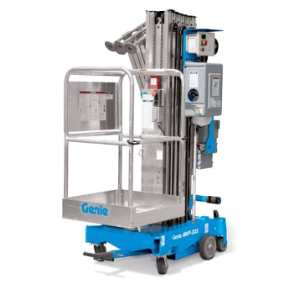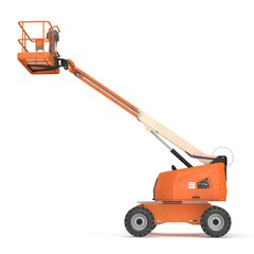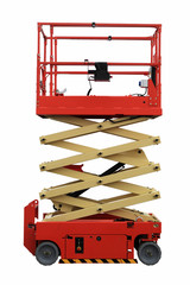


Aerial lifts, also known as mobile elevating work platforms, or MEWPs, are a type of heavy equipment that is used to transport people. Aerial lifts are commonly used to perform service or repair on equipment that is highly elevated or difficult to access, such as lighting, ventilation, electrical, signage, and plumbing fixtures.
Three common types of lifts include:
- Aerial Work Platform – An aerial work platform, also called an AWP or a single-person lift, is a movable mechanical device that raises people, materials or both to higher elevations. Other names for aerial work platforms include man lifts, personnel lifts, and vertical lifts.
- Scissor Lifts – Scissor lifts are a type of mobile scaffold device that can lift people and materials that uses criss-crossed beams to support the work platform.
- Boom Lifts – Boom lifts, sometimes referred to as “cherry pickers” have the ability to reach higher or more difficult areas and are typically used in exterior work. The most commonly used boom lifts are telescoping boom lifts, articulating boom lifts, and bucket trucks.
Because aerial lifts are heavy machinery that can extend to high elevations, there are various hazards associated with lift use.
Hazards can include:
- Falls from elevated levels
- Electrocution (such as from contact with overhead power lines)
- Tip-Overs
- Ejection or catapulting from the lift platform
- Hitting overhead objects, such as ceilings or fixtures
- Being struck by falling objects
General Aerial Lift Safety Guidelines:
- Only trained, authorized individuals may operate an aerial lift at UMBC.
- All lift operators shall review the operator’s manual prior to first time operation (operator’s manuals can be found on the lift manufacturer’s websites).
- Fall protection must be worn at all times when operating a boom lift or when otherwise required by the lift’s manufacturer (refer to Operators Manual).
- Never attach fall protection to a structure other than the lift’s designated anchorage point.
- Do not exit the lift from an elevated position in order to access an external platform or structure.
- Wear the appropriate personal protective equipment when necessary.
- Perform a pre-operation inspection of the lift before the first use of the day or shift. If any deficiencies are noted, report the condition to your supervisor and Environmental Safety and Health, and tag the lift as Out Of Service.
- Never leave keys inside a lift when not in use. Do not leave a lift running unattended.
- Lifts may not be operated within ten (10) feet of overhead power lines.
- Never exceed the load or weight capacity of the lift.
- Unless specifically designed, do not use the lift to carry anything other than people.
- Only one person may occupy the lift basket at a time unless the lift is specifically designed to carry multiple persons.
- Do not operate a lift in severe or inclement weather, such as heavy rain, hail, high winds in excess of 28 miles per hour, or lightning.
Be sure to follow all necessary safety precautions when operating an aerial lift at UMBC. For more information, please review the Aerial Lifts section of the Fall Protection and Working From Heights procedure.